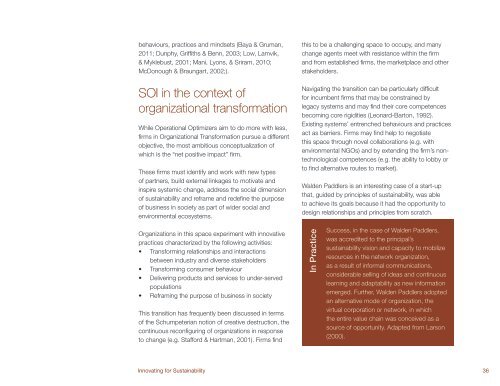Systematic Review - Network for Business Sustainability
Systematic Review - Network for Business Sustainability
Systematic Review - Network for Business Sustainability
Create successful ePaper yourself
Turn your PDF publications into a flip-book with our unique Google optimized e-Paper software.
ehaviours, practices and mindsets (Baya & Gruman,<br />
2011; Dunphy, Griffiths & Benn, 2003; Low, Lamvik,<br />
& Myklebust, 2001; Mani, Lyons, & Sriram, 2010;<br />
McDonough & Braungart, 2002;).<br />
SOI in the context of<br />
organizational trans<strong>for</strong>mation<br />
While Operational Optimizers aim to do more with less,<br />
firms in Organizational Trans<strong>for</strong>mation pursue a different<br />
objective, the most ambitious conceptualization of<br />
which is the “net positive impact” firm.<br />
These firms must identify and work with new types<br />
of partners, build external linkages to motivate and<br />
inspire systemic change, address the social dimension<br />
of sustainability and reframe and redefine the purpose<br />
of business in society as part of wider social and<br />
environmental ecosystems.<br />
Organizations in this space experiment with innovative<br />
practices characterized by the following activities:<br />
• Trans<strong>for</strong>ming relationships and interactions<br />
between industry and diverse stakeholders<br />
• Trans<strong>for</strong>ming consumer behaviour<br />
• Delivering products and services to under-served<br />
populations<br />
• Reframing the purpose of business in society<br />
This transition has frequently been discussed in terms<br />
of the Schumpeterian notion of creative destruction, the<br />
continuous reconfiguring of organizations in response<br />
to change (e.g. Staf<strong>for</strong>d & Hartman, 2001). Firms find<br />
this to be a challenging space to occupy, and many<br />
change agents meet with resistance within the firm<br />
and from established firms, the marketplace and other<br />
stakeholders.<br />
Navigating the transition can be particularly difficult<br />
<strong>for</strong> incumbent firms that may be constrained by<br />
legacy systems and may find their core competences<br />
becoming core rigidities (Leonard-Barton, 1992).<br />
Existing systems’ entrenched behaviours and practices<br />
act as barriers. Firms may find help to negotiate<br />
this space through novel collaborations (e.g. with<br />
environmental NGOs) and by extending the firm’s nontechnological<br />
competences (e.g. the ability to lobby or<br />
to find alternative routes to market).<br />
Walden Paddlers is an interesting case of a start-up<br />
that, guided by principles of sustainability, was able<br />
to achieve its goals because it had the opportunity to<br />
design relationships and principles from scratch.<br />
In Practice<br />
Success, in the case of Walden Paddlers,<br />
was accredited to the principal’s<br />
sustainability vision and capacity to mobilize<br />
resources in the network organization,<br />
as a result of in<strong>for</strong>mal communications,<br />
considerable selling of ideas and continuous<br />
learning and adaptability as new in<strong>for</strong>mation<br />
emerged. Further, Walden Paddlers adopted<br />
an alternative mode of organization, the<br />
virtual corporation or network, in which<br />
the entire value chain was conceived as a<br />
source of opportunity. Adapted from Larson<br />
(2000).<br />
Innovating <strong>for</strong> <strong>Sustainability</strong> 36
















